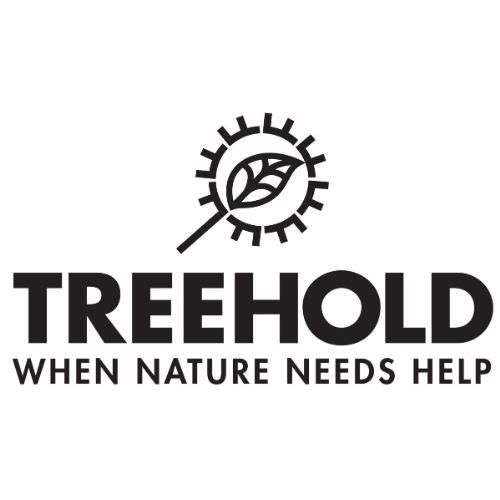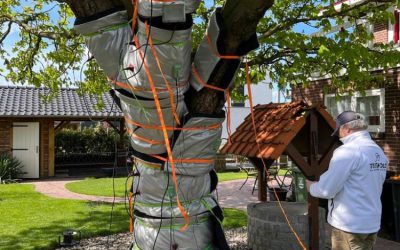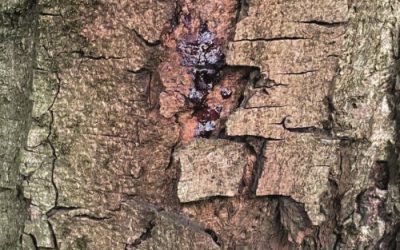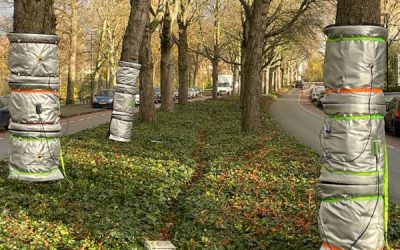Chestnut tree sick?
There is a solution!
Are you a gardener? With the treatment set From TreeHold you can easily treat sick chestnut trees yourself against chestnut bleeding disease.
Contact
+31 (0)85 0065 671
info@treehold.com
Leeghwaterstraat 2B, 2811 DV Reeuwijk
Recognize a sick chestnut tree?
Learn to recognize the symptoms of a sick chestnut tree in order to take timely action.
The advantages of the treatment set at a glance
Proven method
Works simply, safely and quickly.
Sustainable solution
Aimed at preserving chestnut trees.
Short treatment time
A treatment lasts an average of four hours.
Effective treatment
As part of a study, the Municipality of Dordrecht had more than 20 sick chestnut trees treated with the Treehold treatment set. Wageningen University analyzed the collected data and compiled a fixed success rate of 95,6%.
Sustainable, innovative infrared therapy
With the treatment set, sick chestnut trees receive a kind of fever therapy. By heating the bark using infrared, the pathogenic bacteria that cause chestnut bleeding disease are rendered harmless. The tree gets a boost in a sustainable way and can recover.
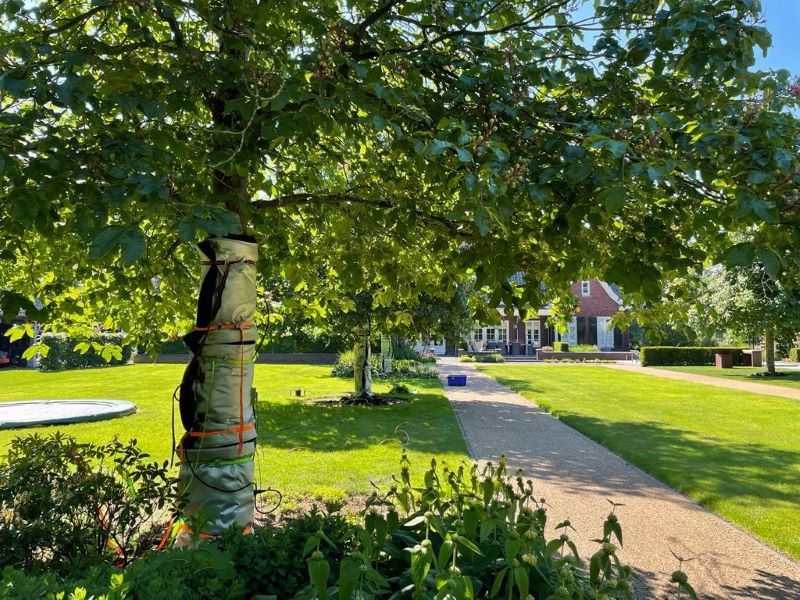
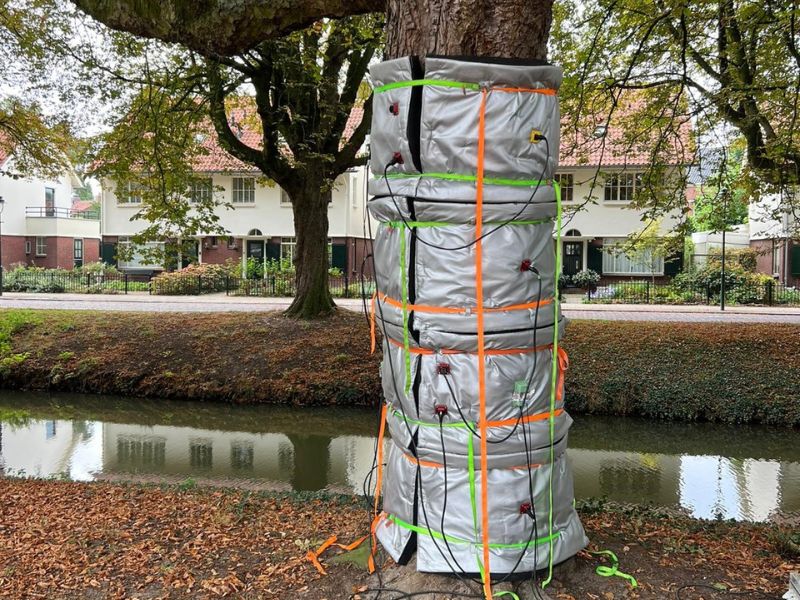
“It looks great so far. The bleeding has stopped and the tree looks great. Very happy with it.”
“I would do it again in a heartbeat! The tree is still in good condition after you have treated it”
"New Year New chances. Fortunately, the chestnut tree still looks picture-perfect!”

Answers to frequently asked questions
What exactly does the TreeHold treatment entail?
The TreeHold Method® is a patented thermal treatment and eliminates pathogenic bacteria by briefly heating them. The trunk and any large branches are completely or partially covered with infrared panels. The radiant heat reaches the sap flow system (the cambium) in a short time, rendering the pathogenic Pseudomonas Syringae bacteria harmless. The total treatment time obviously depends on the size of the tree, but is usually no longer than 4 hours.
Are there alternative methods available?
Alternative method, based on the same heat principle, uses a less efficient technique and has a treatment time of 48 hours. Due to the high costs, this method is no longer used. Alternatives that are based on other principles (for example: injecting the cambium with a herbal extract) currently have no scientific evidence and are hardly applied.
Who applies the method?
The TreeHold method can be used by the green companies and green providers of municipalities themselves. The set is for sale or can be rented. After a short training, employees can easily get started themselves. Of course, treatment can also be outsourced to one of the affiliated gardeners.
What does a treatment cost?
The costs for treatment depend on: (1) the size of the tree, (2) the location and accessibility of the tree and (3) the number of trees treated at the same time. Labor costs are the most important factor. Simple calculation examples (no rights can be derived from them), where we assume a tree with a trunk circumference of 3 meters and a trunk height of 3 meters.
- Suppose a municipality has 1 TreeHold treatment set and treats 24 trees per year (on average 2 per month). In that case, the share of the treatment set in the total cost price is slightly less than EUR 100 per tree;
- if the treatment of one tree is outsourced to a certified gardener or to Bomenconservation Nederland, the costs are on average EUR 850 per tree (excluding VAT);
- If several trees are treated at the same time (grouped in an avenue or park and a maximum of 5 per generator), the price per tree will of course decrease considerably.
NB: the costs of not treating a chestnut tree and allowing it to die far exceed the treatment costs. In addition to the costs of felling (including removal of underground parts), in many cases a new tree will be planned. Depending on the location in the built-up area, costs can amount to up to EUR 5.000 per tree!
When can I see results from a treatment?
If desired, a biopsy from the cambium can be analyzed before and after treatment by Wageningen University or another independent laboratory. Lead time depends on laboratory capacity and is on average 2 months. The result is reported to the client.
A visible result obviously depends on the overall condition of the tree and the growing location, but can be expected after approximately 12 months.
Can every sick tree be treated?
Every tree can be treated! However: TreeHold does not recommend treatment if the chance of recovery is estimated to be very low. This is possible, for example, because the tree has been weakened too much, there are acute safety issues or the growing area cannot be improved sufficiently and recovery is virtually impossible.
Can the method also be applied to bleeding diseases in other trees?
The method certainly works for almost any form of bleeding disorder, caused by a bacteria or fungus. Field research is currently being conducted into the practical feasibility in Kiwi trees, but also European avenue trees other than the Chestnut. Follow us on socials for the results.
Isn't it better to cut down the diseased tree and plant a new one?
In some cases that is indeed the best option. If secondary pathogens are present, especially the Tonder fungus, felling is often the only safe option. However, the trees affected by the Chestnut Bleeding Disease are not necessarily written off. In almost most cases, digging is not necessary and… ecologically and financially also very unwise.
Which bacteria makes the tree sick?
The bleeding in chestnuts is caused by infection with the bacterium Pseudomonas syringae pv aesculi. (source: Wageningen University).
What is the disease course of Chestnut Bleeding Disease?
The bacterium Pseudomonas syringae pv aesculi causes the bleeding and occurs naturally on chestnuts. In wounds in the bark, the bacterium can become pathogenic and attack the cambium, causing it to die, resulting in reduced condition of the tree. Symptoms of infections are rust-colored bleeding, which over time turns into black spots and eventually dying bark. The wounds created below are susceptible to parasitic fungi. These fungi affect the wood quality and can lead to safety risks in the short term. Wounds pose risks and should be avoided. The condition and growth location of the tree are crucial.
Who is involved in the development of the TreeHold method?
We do the technical realization ourselves, in close collaboration with a number of brilliant students from TUDelft. For theoretical validation, TreeHold collaborates extensively with Bologna University in Italy. Wageningen University, as an independent institute, analyzes the samples before and after treatment. Bomendienst, as part of iDverde Netherlands, analyzed the practical applicability and was involved in various pilot studies.
Is the method guaranteed effective?
TreeHold cannot give any guarantees! A tree is a living organism and the success of treatment with the TreeHold method depends on various factors. The methodology has been scientifically validated. Treated trees are monitored for a long time by the Tree Service of iDverde Netherlands. If necessary, trees are treated completely or locally.
I am a private individual, who can I report to?
Private individuals can contact Dennis Kemp from our partner company Bomenconservation Nederland BV. The contact details are (06 27007172 | info@treeconservationnederland.nl). Of course, they can also turn to a certified gardener.
I am a gardener and would like to use the set, how can I achieve this?
TreeHold is a tech company in the green domain and is always looking for gardeners/tree surgeons and other green providers to apply its methods. If you work under the BVC quality mark, please contact us via the “Contact” heading or call/email Marc Derksen directly (06 51 139 956 / derksen@treehold.com).
As a civil servant, I am (jointly) responsible for greenery in the municipality/province, how can I obtain more information?
If a municipality has its own TreeHold treatment set, the treatment can be carried out by: (1) its own people or (2) by a certified gardener. Of course, a municipality without its own set can also outsource the whole thing to a certified gardener.
Contact us via the “Contact” heading or call Marc Derksen directly (06 51 139 956).
I am a private individual or company and would like to sponsor a treatment, is that possible?
A financial contribution to the treatment of specific trees at a specific location is also welcome, but is always coordinated with the responsible officials in a municipality.
News
Green light for new research from University of Bologna
Green light for new research from the University of Bologna into the protection of young trees against the East Asian longhorn beetle, Anaoplophora chinesis. University of Bologna approves extensive research The greentech company TreeHold has given the green light...
Recognize a sick chestnut tree?
Recognize a sick chestnut tree? Learn to recognize the symptoms of a sick chestnut tree in order to take timely action. Chestnut trees are majestic trees that are often found in parks, gardens and along avenues. Unfortunately, these trees are susceptible to several...
Infrared treatment against bleeding disorders now applicable as an industrial set.
Infrared treatment against bleeding disorders now applicable as an industrial set. Infrared treatment against bleeding disorders can now be used as an industrial set Innovator par excellence brings infrared heating technology for avenue trees to the market as a step towards robotization...
